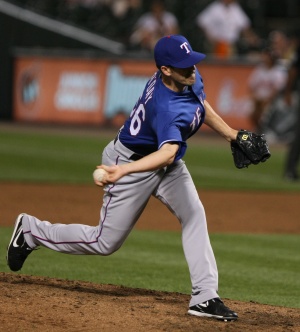Thrower's Shoulder: Difference between revisions
No edit summary |
No edit summary |
||
| Line 10: | Line 10: | ||
== Further Information == | == Further Information == | ||
Treatment of the Thrower's shoulder is exceptionally challenging. Awareness and understanding of the throwing motion and the forces the structures are subject to are essential to diagnosis and treatment. See [[Throwing Biomechanics|Throwing biomechanics]] | Treatment of the Thrower's shoulder is exceptionally challenging. Awareness and understanding of the throwing motion and the forces the structures are subject to are essential to diagnosis and treatment. See [[Throwing Biomechanics|Throwing biomechanics]] | ||
Injuries specific to throwers usually involve the labrum and the undersurface of the rotator cuff. Tissue changes are also seen in the anterior and posterior glenohumeral capsule, altering the biomechanics. | |||
SLAP Tears | |||
Bicep Tendinitis and Tendon Tears | |||
Rotator Cuff Tendinitis and Tears | |||
Internal Impingement | |||
Instability | |||
Glenohumeral Internal Rotation Deficit (GIRD) | |||
Scapular rotation dysfunction | |||
The majority of patients who have been identified as having internal impingement are overhead athletes or throwing athletes (tennis, volleyball players, swimmers, or baseball players). Please redirect your reading to [[Internal Impingement of the Shoulder]] and | The majority of patients who have been identified as having internal impingement are overhead athletes or throwing athletes (tennis, volleyball players, swimmers, or baseball players). Please redirect your reading to [[Internal Impingement of the Shoulder]] and | ||
Revision as of 02:18, 12 January 2023
Original Editors - Samuel Jacob Melnick
Lead Editors- Severo Saenz, Samuel Jacob Melnick, Ian Wallace, Matthew Seliga
Introduction[edit | edit source]
Overhead throwing places exceptionally high stresses on the shoulder. The thrower's shoulder must be loose enough to allow excessive external rotation but stable enough to prevent symptomatic humeral head subluxations, requiring a delicate balance between mobility and functional stability. This balance is frequently compromised and believed to lead to various types of injuries to the surrounding tissues.[1]
Further Information[edit | edit source]
Treatment of the Thrower's shoulder is exceptionally challenging. Awareness and understanding of the throwing motion and the forces the structures are subject to are essential to diagnosis and treatment. See Throwing biomechanics
Injuries specific to throwers usually involve the labrum and the undersurface of the rotator cuff. Tissue changes are also seen in the anterior and posterior glenohumeral capsule, altering the biomechanics.
SLAP Tears
Bicep Tendinitis and Tendon Tears
Rotator Cuff Tendinitis and Tears
Internal Impingement
Instability
Glenohumeral Internal Rotation Deficit (GIRD)
Scapular rotation dysfunction
The majority of patients who have been identified as having internal impingement are overhead athletes or throwing athletes (tennis, volleyball players, swimmers, or baseball players). Please redirect your reading to Internal Impingement of the Shoulder and
References[edit | edit source]
- ↑ Wilk et al. Shoulder Injuries in the Overhead Athlete. J Orthop Sports Phys Ther. 2009;39(2):38-54. Article







